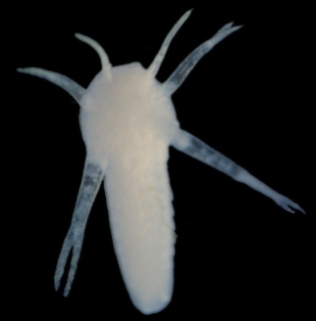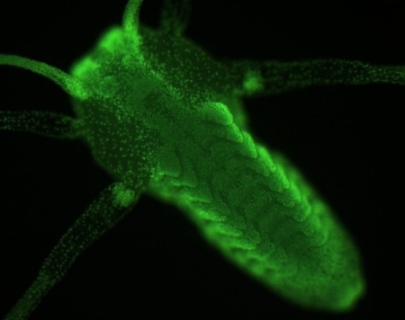Current number of accepted species: 28
Remipedia - a small class apart
Remipedia represent a comparatively small group of crustaceans, with only 20 living species assigned to three families. The first specimens were discovered three decades ago during a cave diving expedition on Grand Bahamas Island (Yager, 1981).
At first glance, a remipede does not look much like a crustacean at all. The remipede trunk is long and undivided, composed of 15 to 42 homonomous segments. It does not exhibit a structural subdivision into two or more distinct body regions, such as a thorax followed by an abdomen, or a pleon. Among the morphological disparity of crustacean forms, this body plan is unique, and superficially, remipedes bear a certain resemblance to another, terrestrial group of arthropods, the Myriapoda (Fig. 1).
However, upon closer examination, remipedes reveal a number of characters that they share with many crustaceans. These include, among others, two pairs of antennae, each with two branches; the morphology of some of the mouthparts; paddle-shaped trunk limbs, also composed of two branches; and a posterior body terminus with caudal rami.
To date, all living remipedes, assigned to the order Nectiopoda, have been found exclusively in marine cave systems (Fig. 2). These caves are often land-locked water bodies, with subterranean connections to the ocean (anchialine cave systems). All nectiopods are eyeless and whitish-transparent - the loss of eyes and pigmentation are typical adaptations to life in subterranean environments. Remipedes are hermaphrodites, bearing female gonopores on the seventh trunk segment and male pores on segment 14. Their head region is armed with three pairs of prehensile limbs (Fig. 3). Because of these powerful raptorial appendages remipedes were, evidently, considered obligatory predators. This view was supported by occasional reports from cave divers, who observed remipedes hunting and catching comparatively large cave shrimps. However, our behavioral observations of remipedes maintained in tanks could not confirm an exclusively carnivorous mode of feeding (Koenemann et al. 2007b; see also a video summary of behavioral observations here). Six individuals - observed over a 2-3 months period - spent more than 99% of observation time filter- or particle-feeding. A variety of prey organisms offered to the remipedes were largely ignored, and predation could be observed in only three cases. |
 Fig. 1. Left: Living specimen of Speleonectes tanumekes Koenemann et al., 2003; photo courtesy of Thomas Iliffe. Right: Habitus drawing of Speleonectes parabenjamini (dorsal view); modified from Koenemann et al. 2007a. |
 Fig. 2. Remipedia are exclusively known from submerged cave systems (shown here: Carwash Cenote, Yucatan Peninsula). The impressive stalagmites and stalactites in front of a diver illustrate that this anchialine cave must have been a dry cave for a long period of time. The cave system ultimately submerged as a result of rising sea levels after Pleistocene glaciations. Photo courtesy of Thomas Iliffe. |
 Fig. 3. Ventral view of a living specimen of Pleomothra fragilis Koenemann et al., 2008; head region featuring powerful prehensile cephalic limbs. Photo by Thomas Iliffe. |
There are still many aspects of the biology of Remipedia we do not know at all. These unresolved issues have certainly contributed to the enigmatic aura that surrounds this group of arthropods. For example, it is not known how "old" remipedes are from a paleogeographic point of view. We are also not certain about the phylogenetic position of Remipedia within the Crustacea. Moreover, there was literally nothing known about the modes of reproduction and development in remipedes until recently.
In 2006, cave diving teams led by Thomas Iliffe from Texas A&M University succeeded - for the first time - in collecting remipede larvae that represented different developmental stages. The naupliar larvae, collected directly from the water column in an anchialine cave system, allowed us to reconstruct the post-embryonic development of Remipedia more than 25 years after their discovery (Koenemann et al. 2008, 2009).
 |
 |
Fig. 4. Left: Living metanauplius of Pleomothra apletocheles (ventral view); photo courtesy of Thomas Iliffe. Right: CLSM photo of metanauplius showing ventral arrangement of developing limb buds.
References
- Koenemann, S., Iliffe, T.M. & van der Ham, J. 2003. Three new species of remipede crustaceans (Speleonectidae) from Great Exuma, Bahamas Islands. Contributions to Zoology 72 (4): 227-252.
- Koenemann, S., Olesen, J., Alwes, F., Iliffe, T.M., Hoenemann, M., Ungerer, P., Wolff, C. & Scholtz, G. 2009. The post-embryonic development of Remipedia (Crustacea) - additional results and new insights. Dev Genes Evol: DOI 10.1007/s00427-009-0273-0.
- Koenemann, S., Schram, F.R., Hoenemann, M. & Iliffe, T.M. 2007a. Phylogenetic analysis of Remipedia (Crustacea). Org., Divers. & Evol. 7: 33-51.
- Koenemann, S., Schram, F.R., Iliffe, T.M., Hinderstein, L.M. & Bloechl, A. 2007b. The behavior of Remipedia (Crustacea), with supporting field observations. Journal of Crustacean Biology 27 (4): 534-542.
- Koenemann, S., Ziegler, M. & Iliffe, T.M. 2008. Pleomothra fragilis n. sp. (Remipedia) from the Bahamas, with remarks on morphologic reductions and postnaupliar development. Journal of Crustacean Biology 28 (1): 128-136.
- Yager, J. 1981. A new class of Crustacea from a marine cave in the Bahamas. J. Crust. Biol. 1: 328-333.
Editorial board
Editor
Stefan KoenemannUniversity of Veterinary Medicine Hannover, Institute for Animal Ecology and Cell Biology, Evolutionary Ecology and Systematics
Buenteweg 17 d, 30559 Hannover
Germany
Associate Editors
Mario HoenemannUniversity of Veterinary Medicine Hannover, Institute for Animal Ecology and Cell Biology, Evolutionary Ecology and Systematics
Buenteweg 17 d, 30559 Hannover
Germany
Torben Stemme University of Veterinary Medicine Hannover, Institute for Animal Ecology and Cell Biology, Evolutionary Ecology and Systematics
Buenteweg 17 d, 30559 Hannover
Germany
Citation
Usage of data from the World Remipedia Database in scientific publications should be acknowledged by citing as follows:- Koenemann, S.; Hoenemann, M.; Stemme T. (2026). World Remipedia Database. Accessed at https://www.marinespecies.org/remipedia on 2026-01-03
Individual pages are individually authored and dated. These can be cited separately: the proper citation is provided at the bottom of each page.
Photo credits
Pictures in the banner and background are from Thomas Iliffe.